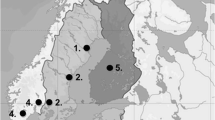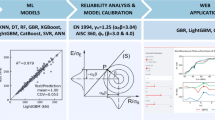Summary
A computer simulation model is developed for predicting modulus of elasticity (E) of uniform lumber measured at high speed by stress-grading machines of the constant-deflection type. Simulations carried out with the model showed that speed had no significant effect on the average E measured along the lumber but largely affected E values measured at individual locations. Tests conducted at 15, 150 and 315 m/min with two machines employing different supports conditions confirmed model predictions. Ability of the grading machines to identify local E values at high speed could be improved by proper filtering of the load signal recorded by the machine.
Similar content being viewed by others
References
Hoyle, R. J., Jr. 1961: A nondestructive test for stiffness of structural lumber. Forest Prod. J. 11: 251–254
Hoyle, R. J., Jr. 1968: Background to machine stress grading. Forest Prod. J. 18 (4): 87–97
Kaliteevskii, R. E.; Ogurtsov, V. V. 1975: Effect of the speed of longitudinal lumber movement on stress-grading parameters. Lesnoi Zhurnal 5: 134–138 (In Russian)
Logan, J. D. 1978: Machine stress rating. Proceedings of the 4th Nondestructive Testing of Wood symposium. Vancouver, WA., pp. 285–303
Mote, C. D., Jr. 1965: Some dynamic characteristics of band saws. Forest Prod. J. 15 (1): 37–41
Mote, C. D., Jr. 1968: Dynamic stability of an axially moving band. J. of the Franklin Institute 285: 329–346
Pellerin, R. F. 1976: Non-destructive evaluation of wood and wood products. Proceedings from IUFRO Wood Engineering Group meeting, Denmark/Norway, Paper 19
Pelster, S. 1963: The Stress O-Matic stress rating system. Proceedings of the symposium on Nondestructive Testing of wood. Forest Prod. Lab., Madison, WI
Reddy, J. N. 1984: An introduction to the finite element method. New York: McGraw-Hill
Samson, M. 1985: Finite element model for predicting modulus of elasticity of lumber measured by stress-grading machines. Wood a. Fiber Sc. 17: 490–503
Samson, M. 1986: Predicted and actual performance of two laboratory stress-grading machines employing different support conditions. Wood a. Fiber Sc. 18: 478–489
Author information
Authors and Affiliations
Additional information
Experimental data analysed in this paper were collected when the author was a Research Scientist at Forintek Canada Corp., 6620 N.W. Marine Dr., Vancouver, B.C., Canada, V6T 1X2. The author is grateful to H. Fraser and L. S. Olson from Forintek for their assistance in perfoming the experiments. Financial support of the Natural Sciences and Engineering Research Council of Canada is gratefully achnowledged.
Rights and permissions
About this article
Cite this article
Samson, M. Effect of speed on the accuracy of stress-grading machines for lumber. Wood Sci. Technol. 21, 281–292 (1987). https://doi.org/10.1007/BF00351400
Received:
Issue Date:
DOI: https://doi.org/10.1007/BF00351400




